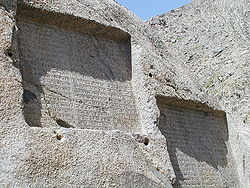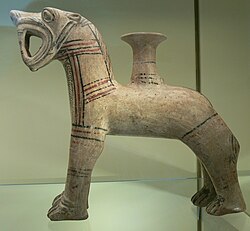Persia - Achaemenian Vessels
- Front:
- A ceremonial drinking cup shaped like an animal head or horn with a beautiful leonine creature, Achaemenid era; 5th century B.C.
- Iran
Gold; H. 17 cm Fletcher Fund, 1954 (54.3.3)
- Horn-shaped vessels ending in an animal's head have a long history in the Near East as well as in Greece and Italy. Early Iranian examples are straight, with the cup and animal head in the same plane. Later, in the Achaemenid period, the head, or animal protome, was often placed at a right angle to the cup, as in this piece. In the manufacture of this gold vessel, several parts were invisibly joined by brazing, which demonstrates superb technical skill. One hundred and thirty-six feet of twisted wire decorate the upper band of the vessel in forty-four even rows, and the roof of the lion's mouth is raised in tiny ribs. Typical of Achaemenid style, the ferocity of the snarling lion has been tempered and restrained by decorative convention. The lion has a crest running down his back; his mane has the disciplined appearance of a woven material; and his flanks are covered by an ostrich plume. The inclusion of the plume, a departure from convention, suggests that this lion is winged and has some supernatural significance.
- Back:
- Fluted bowl, Achaemenid, Darius I or II; 522-486 B.C. or 432-405 B.C.
Iran Gold; H. 11.1 cm Harris Brisbane Dick Fund, 1954 (54.3.1)
- In the sixth century B.C., under the leadership of Cyrus the Great (r. 538-530 B.C.), the Achaemenid Persian dynasty overthrew Median kings and established an empire that would eventually extend from eastern Europe and Egypt to India. Achaemenid rulers included such famed kings as Cyrus, Darius I (r. 521-486 B.C.), and Xerxes I (r. 485-465 B.C.). They built palaces and ceremonial centers at Pasargadae, Persepolis, Susa, and Babylon. The Achaemenid Dynasty lasted for two centuries and was ended by the sweeping conquests of Alexander the Great, who destroyed Persepolis in 331 B.C. The Achaemenid period is well documented by the descriptions of Greek and Old Testament writers as well as by abundant archaeological remains.
Fluted bowls and plates of the Achaemenid period continue a tradition begun in the Assyrian Empire. While they were given as royal gifts, it seems that they were also valued and exchanged simply for the weight of the precious metals from which they were made.
- Photo taken in the Metropolitan Museum, New York.
Relevante Bilder
Relevante Artikel
TiergefäßTiergefäße, auch als zoomorphe oder tiergestaltige Gefäße bezeichnet, sind Gefäße in Tierform, die im Alten Orient kultischen Zwecken dienten. Sie werden aufgrund ihrer Form häufig als Rhyton bezeichnet. Sie sind vor allem in Anatolien und Syrien verbreitet, wobei Stier- und Hirschgefäße in Anatolien, Löwengefäße in Syrien verbreiteter waren. Sie wurden für Trankopfer (Libationen) benutzt, wobei eine Beziehung zwischen Tierart und verehrter Gottheit bestand. .. weiterlesen
EkbatanaEkbatana war die Hauptstadt des Mederreichs und später Königsresidenz im persischen Achämenidenreich. Sie befand sich auf dem Gelände oder im Umfeld der heutigen iranischen Großstadt Hamadan, deren Name sich aus dem altpersischen Namen ableitet. .. weiterlesen
RhytonDas Rhyton ist ein gewöhnlich einhenkeliges Trinkgefäß oder Spendegefäß zum Ausgießen von Trankopfern durch eine Öffnung im unteren Bereich. Rhyta kommen oft in Form von Tierprotomen wie Stier- oder Widderköpfen vor. .. weiterlesen












